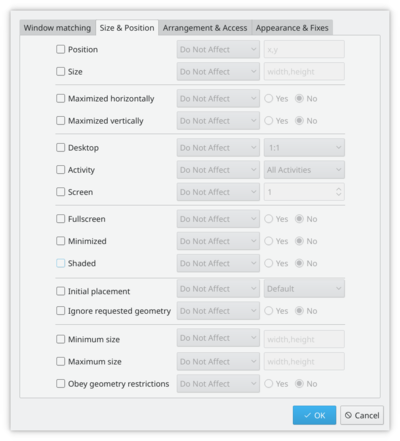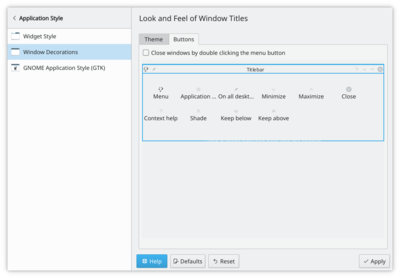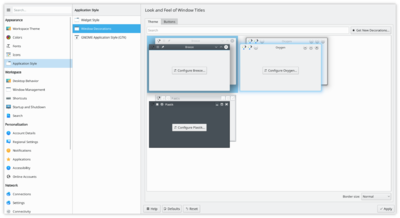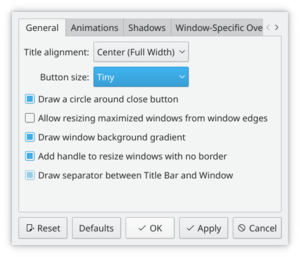KWin
 |
Der verlässliche und flexible Fenster-Manager des KDE Plasma Desktops, jetzt mit Effekten! |
Feature-Übersicht
- Stabil und verlässlich
- Compositing, 3D-Effekte
- Einfache Konfigurierung
- Verbesserte Leistungsfähigkeit
KWin (sprich "kwin") ist der Fenstermanager für den KDE Plasma Desktop. Es gibt Ihnen die vollständige Kontrolle über Ihre Fenster, so dass Sie nicht im Weg sind, aber Ihnen bei Ihren Aufgaben helfen. Er malt die Fensterdekoration, die Bar am Anfang von jedem Fenster mit (konfigurierbar) Schaltflächen wie zu schließen, zu maximieren und zu minimieren. Es verwaltet auch dass platzieren von Fenstern und das Umschalten zwischen ihnen.
KWin unterstützt 'Compositing', der Umgang mit Ihren Fenstern mittels 3D-Effekten. Dies kann dazu führen, das dass Fenstermanagement glatter, leichter, effizienter und natürlicher wird. Die Hardware-Anforderungen sind sehr bescheiden, und so ziemlich jedes halbwegs moderne System seit 2002 unterstützt wird. Es gibt noch einige Probleme mit bestimmter Hardware, weitere Infos darüber finden Sie auf techbase
Nützliche Funktionen
Click with your right mouse button on a window decoration or use System Settings to access the new and easier configuration of KWin. Here you can enable effects to more efficiently manage your windows. You can for example use the Present Windows as the effect for window switching. Instead of showing you icons or very small previews of your applications, it arranges them in a grid so you can quickly choose the right one. Just use the Alt-Tab keysequence and keep the Alt key pressed. You can now use tab to switch through the windows or just activate the right one using the mouse. Hitting Alt-Tab keys quickly will show you the next window in the queue, just like it used to.
If your X server already supports compositing, switching it on is as easy as opening System Settings, opening the module, choosing and enabling the checkbox . More advanced compositing settings (such as Use VSync, Scale method, Compositing type) are available through the dialog. Customising the behaviour of the KWin effects means opening the tab, and choosing the plugins you want to use. Please note that only a subset of the plugins works with XRender-based compositing. For the full experience, you need to use OpenGL mode.
Employing motion physics, KWin provides your windows with a more natural feel. New desktop effects like the Cube desktop switcher and Magic Lamp minimize animation have been added. Improvements in the existing effects make window management smoother than ever. KWin has seen many performance improvements to enable these effects even on low-end hardware. Elaborate checks have been build in to ensure users with low-end hardware are not presented with an unusable setup. KWin detects the capabilities of the hardware and if needed gracefully scales its effects down. You can take control and disable these checks or change settings like the global animation speed to fine-tune your experience. When your computer is under heavy load, KWin will automatically disable the compositing temporarily to keep things running smoothly. It will notify you if it does so, and you can re-enable compositing by pressing Shift+Alt+F12. Finally, support for multiple screen handling has been improved in KWin using the new Kephal library. You can move maximized windows between Xinerama screens and the addition of external screens is handled correctly.
More information about what was introduced in KDE SC 4.9 can be found at the following link:
Tutorials
Eine Anwendung immer mit einer bestimmten Größe und/oder Position starten

Sometimes the screen position of an application is vital to your comfort, so use the flexibility of KWin to make sure it's always where you want it.
Position the window where you want it to open, then right-click on the title-bar, choosing . This will open a settings window, with appropriate entries already made. All you need to do now is select the tab and check and . OK - you are finished!
Script the window manager from the command line
Use the WMIface utility.
Die Position der Titelleisten-Knöpfe verändern

Take a look at tab. The options open to you may depend on your distribution or theme, and it's clear that there is more to come.
To simply move things around you work with the specimen titlebar - that is the dark blue bar with a large KDE on it. Drag icons there and you will see them move in the preview window at the bottom of the screen.
You may find that you have other icons available to you. A circle indicates that the button will set that window on all desktops. Another icon that you may find useful is Shade - a toggle between rolled up (titlebar only visible) and normal view. These icons are added by dragging from the text description window onto the speciman title bar - just position them as you want to use them.
Falls Sie einen klassischen KDE3-ähnlichen Desktop bevorzugen

|
| Change to traditional desktop |
Right-click on your desktop - select (or , in some distros). Change the from to . The whole desktop is now a folderview, and another right-click on the desktop will allow you to select . Set the folderview to the directory you want to use as your desktop.
Open applications directly into a different desktop
Verwenden Sie einen Befehl, wie:
kstart5 --desktop 4 kate
Verwendung auf kleinen Bildschirmen (z. B. Netbooks)
Die Fensterdekoration verkleinern

tab. Two good options there:

- Using the default style (Breeze), select and set to or .
- Using an other style, with smaller windows decorations.
Both routes will give you slim and functional window titles and borders.
Change the base fonts
On many netbooks the screen is very clear, so that reading fonts much smaller than you expect is feasible. On Acer Aspire One I find that 8 point is a good base settings.
Schriftart in Firefox verkleinern
Experimentation with did not bring satisfactory results. Do this instead. Download and install gtk-chtheme from this website. Using that tool you can either set a specific font size, or better still, tell it to use your KDE desktop settings. This will work with Firefox as well as any gtk applications that you use.
KMail's Aggregation options take up too much space
Siehe dieses FAQ um es zu ändern.
KMail's Aggregation Optionen nehmen zu viel Platz ein
See this FAQ to change their behaviour
Gallery
The Gallery holds many screenshots of past and present desktops and effects.
Troubleshoot Graphics Problems
Curing graphics problems depends on knowing the correct drivers for your graphics card. Learn more about this on the Desktop Effects Performance page.
Defining Window Rules
There is a tutorial on defining your own rules for the behaviour of specific windows on the KWin Rules pages.
